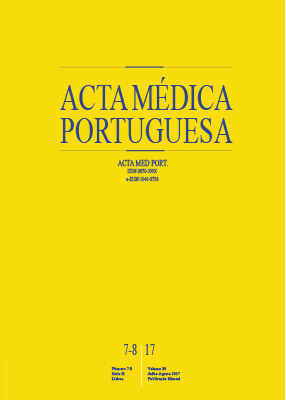Morbidity in the Dependent Elderly Cared by Home-Teams of the National Network of Continued Integrated Care in the Lisbon and Tagus Valley: Cross-Sectional Study
DOI:
https://doi.org/10.20344/amp.8128Keywords:
Aged, 80 and over, Frail Elderly, Homes for the Aged, Long-Term Care, PortugalAbstract
Introduction: In Portugal, the National Network of Continuing Integrated Care’s mission is to take care of new health and social needs. The aim of the study was to know the disease burden and disability of the elderly (75 and over) cared by the integrated continuing care teams.
Material and Methods: A cross-sectional study carried out in a sample of 230 participants, from 25 teams randomly selected in the region of Lisbon and Tagus Valley. Data were collected at the patient’s home trough caregiver’s interviewing. The variables studied were: socio-demographic; disability determinants; degree (Barthel’s scale) and duration of disability; morbidity (diagnoses, number and Charlson index).
Results: The study population had: on average 84 years; low or no scholar degree level (88.7%); on average 9.5 problems per person and a Charlson index of 8.48; disability over 42 months (severe in 65.2%). The most frequent disability-determinants were: dementia, stroke and femur fracture. The most frequent diagnoses were: osteoarthritis, hypertension and dementia.
Discussion: The results revealed a high disease burden (Charlson of 8.48) and disability. Although the diagnoses were those expected and comparable with the literature, their coexistence was universal, averaging 9.5 per person, affecting different organs/systems. Multimorbidity, coupled with severe disability, leads to clinical and organizational-care challenges, as well as the need for other population base studies.
Conclusion: The population cared by the integrated continuing care teams is at risk: elderly, with low scholar degree level, with a high disease-burden and disability.
Downloads
Downloads
Published
How to Cite
Issue
Section
License
All the articles published in the AMP are open access and comply with the requirements of funding agencies or academic institutions. The AMP is governed by the terms of the Creative Commons ‘Attribution – Non-Commercial Use - (CC-BY-NC)’ license, regarding the use by third parties.
It is the author’s responsibility to obtain approval for the reproduction of figures, tables, etc. from other publications.
Upon acceptance of an article for publication, the authors will be asked to complete the ICMJE “Copyright Liability and Copyright Sharing Statement “(http://www.actamedicaportuguesa.com/info/AMP-NormasPublicacao.pdf) and the “Declaration of Potential Conflicts of Interest” (http:// www.icmje.org/conflicts-of-interest). An e-mail will be sent to the corresponding author to acknowledge receipt of the manuscript.
After publication, the authors are authorised to make their articles available in repositories of their institutions of origin, as long as they always mention where they were published and according to the Creative Commons license.









